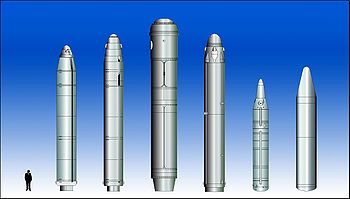- R-39 Rif
-
R-39 Type Strategic SLBM Service history In service 1983–2004 Used by Soviet Union / CIS Production history Manufacturer designed by Specifications Weight 84 tonnes Length 16 m (8.4 m without warhead) Diameter 2.4 m Warhead 6 - 10 Blast yield 100 - 200 Kt each Engine three stage solid-fuel Operational
range8,250 km Guidance
systemAstroinertial The R-39 Rif, or Rif-Ma[1] was a Russian submarine launched ballistic missile (SLBM). It had the NATO reporting name of SS-N-20 Sturgeon and the bilateral arms control designation RSM-52. It was carried on board submarines of the Typhoon class from 1983 until it was withdrawn from service in 2004.
The R-39 was an intercontinental missile, it had a three stage solid-fuel boost design with a liquid-fuel post-boost unit carrying up to ten MIRV warheads. Like other SLBMs the initial launch was powered by a gas generator in the bottom of the firing tube, during the missile's passage through the water additional motors produce a gaseous wall around the missile, reducing hydrodynamic resistance. The launch system was designated D-19.
The missiles had GRAU indices of 3M65, 3M20, and 3R65.
Development work began at NII Mashinostroyeniya in 1971 and the design gained official approval in 1973. Initial test flights from 1979 found problems in the solid-fuel boost engines, over half of the early flights failed. Later tests aboard a modified Typhoon class submarine were more successful and deployment began in May 1983, with 20 missiles in each submarine. At full deployment, 120 missiles were deployed with 1,200 total warheads.
Under the terms of the Start I and Start II treaties, from 1996 a number of R-39 missiles were destroyed. Throughout the 1990s, Typhoon class submarines and the R-39 missiles they carried were gradually withdrawn from service. All the missiles were decommissioned by 2004 and all the Typhoon class submarines have been retired, except for one which is to be used as a test platform for the next generation Bulava missile.
A successor design, R-39M Grom (Russian: Гром, Thunder)/RSM-52V/SS-N-28 for D-19UTTKh launch system, suffered a succession of testing failures and was cancelled.
Contents
Operators
See also
References
External links
- Russian nuclear forces 2005, The Bulletin of the Atomic Scientists, March/April 2005.
- GlobalSecurity.org data on R-39
- GlobalSecurity.org data on R-39M
- GlobalSecurity.org data on Typhoon submarines
Russian and former Soviet military designation sequences N radars N001 Myech/Panda · N002/N006/N008/RP-23 Ametist/Saphir-23M · N005/RP-25 Saphir-25 N007/RP-31 Zaslon · N010 Zhuk · N011 Bars · N012 · N014 · N019/RP-29 Rubin/Topaz · N025 · N035 Irbis · N050
P radar stations, missiles, rockets P-1 Strela (Shchuka) · P-3 radar · P-5 Pyatyorka · P-8 radar · P-10 radar · P-12 radar · P-14 radar · P-15 radar · P-18 radar · P-19 radar · P-20 radar · P-15 Termit · P-30 radar · P-35 radar · P-40 radar · P-70 radar · P-20M/P-70 Ametist · P-80 Zubr · P-100 Oniks · P-120 Malakhit · P-270 Moskit · P-120 Malakhit · P-500 Kliver radar · P-500 Bazalt · P-700 Granit · P-750 Grom · P-800 Oniks · P-1000 Vulkan
R missiles, rockets R, RD engines Others Categories:- Submarine-launched ballistic missiles of the Soviet Union
- Submarine-launched ballistic missiles of Russia
Wikimedia Foundation. 2010.

